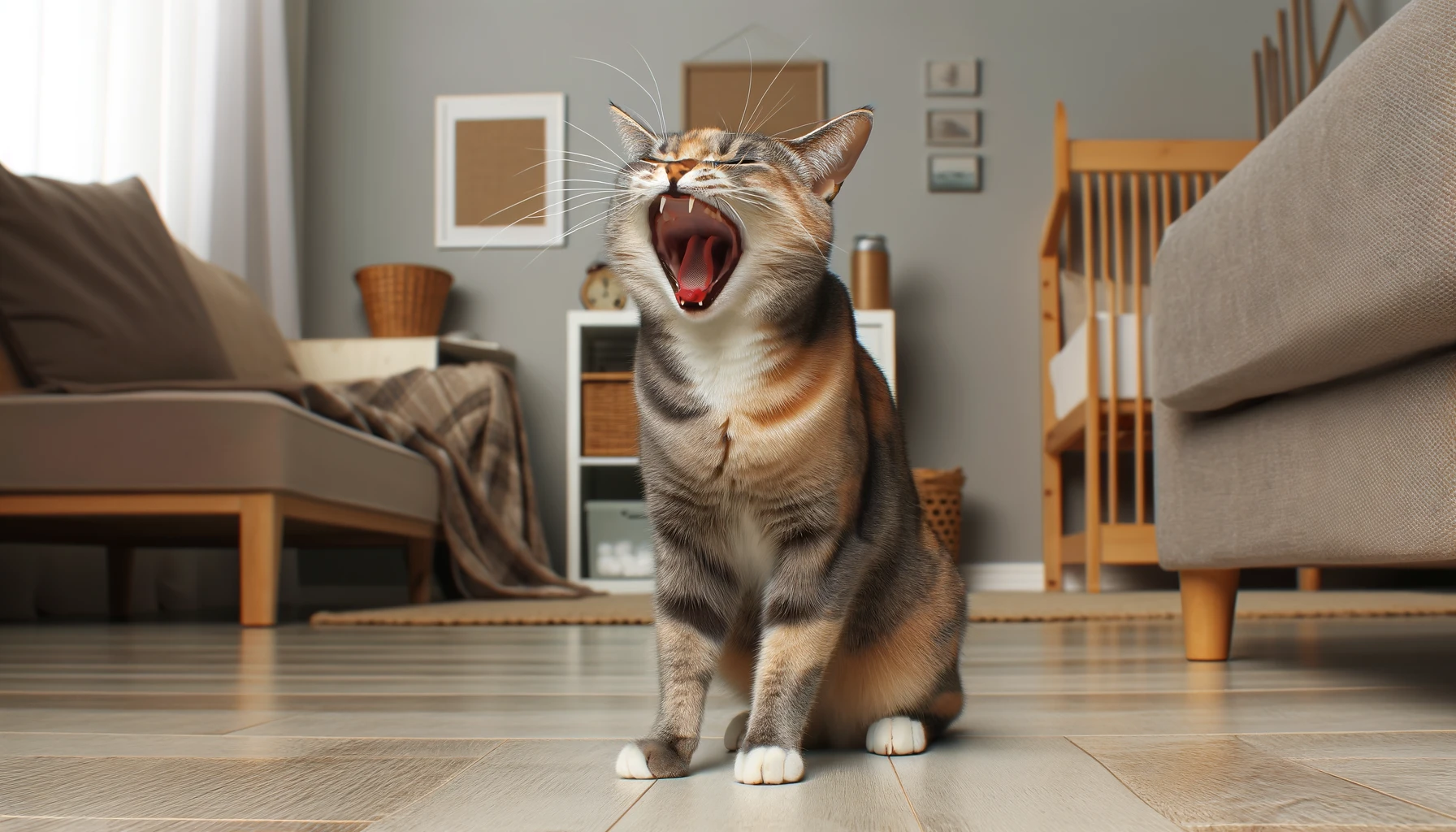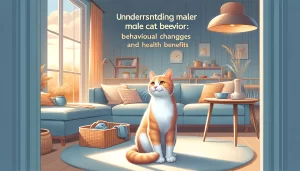Have you ever been jolted awake in the dead of night by the piercing yowls of your spayed female cat? Imagine this: It’s 3 AM, and instead of enjoying a peaceful sleep, you find yourself trying to decode the distressing cries echoing through your home. This behavior, both unexpected and bewildering, often leaves pet owners searching for answers and solutions. Why would a cat, particularly one that has undergone spaying, resort to such loud and persistent vocalizations? Through this article, we delve into this intriguing question, exploring the myriad of reasons that could be behind your spayed female cat’s yowling. We aim to provide you with a deeper understanding of this behavior and offer practical advice on how to create a more tranquil living environment for both you and your cherished companion. Our ultimate goal? To foster a better comprehension of your feline friend, paving the way for a harmonious and joyful life together.
Spaying Surgery Unveiled: A Lifesaving Procedure for Your Cat
Spaying surgery, also known as sterilization, plays a pivotal role in preventing pet cats from breeding, thereby helping to control the cat population and mitigate health risks. This surgical procedure entails the removal of a female cat’s reproductive organs, specifically the uterus and ovaries, rendering it a permanent method of birth control. Beyond population control, spaying is instrumental in diminishing the likelihood of certain health complications, including but not limited to, breast cancer and ovarian cancer. Veterinarians often recommend performing this operation while the cat is still young, aiming to reduce surgical risks and facilitate a swift recovery.
The effects of spaying on a cat can be categorized into immediate and long-term consequences. In the immediate aftermath, it’s common for cats to require a period of recuperation, during which they might display atypical behaviors, such as yowling. This behavior could stem from the discomfort or pain experienced post-surgery, potentially causing the cat to feel anxious or distressed. On the long-term horizon, however, spaying is acknowledged for its capacity to enhance a cat’s overall health by significantly lowering the risk of developing severe health issues.
Medical Reasons Behind Why My Spayed Female Cat Is Yowling
Yowling from your spayed female cat might be more than just a call for attention; it could indicate underlying medical conditions that need to be addressed. While it’s true that yowling can sometimes serve as a means for your cat to express discontent or seek attention, it’s essential to recognize when it might signal something more serious. Delving into the medical reasons behind yowling is critical for the well-being of your cherished pet.
Pain or Discomfort: Post-surgical pain leading to yowling.One of the most common medical reasons for yowling in spayed female cats is post-surgical pain. If not properly managed, this discomfort can lead to vocal expressions of pain. Moreover, conditions such as urinary tract infections or arthritis are also known to cause significant discomfort, manifesting in yowling as a symptom.
Hormonal Changes: Residual tissues producing hormones. Despite undergoing spaying, some cats may still experience hormonal fluctuations that influence their behavior. In instances where not all reproductive tissues are completely removed, the residual tissues may continue to produce hormones, thereby inducing yowling.
Psychological Factors: Anxiety and stress causing yowling. Emotional distress, including anxiety, stress, or past trauma, can also trigger yowling. The post-operative recovery period can be particularly stressful for cats, intensifying feelings of insecurity or discomfort in their recovery environment.
Beyond the Yowls: Behavioral and Environmental Triggers
As we explore the behavioral and environmental triggers, it’s crucial to consider how they relate to female cat behavior after spaying, shaping the way our feline friends communicate. When your spayed female cat starts yowling, it might not just be a physical issue; these factors can also play a significant role, like solving a mystery where every clue counts. Let’s explore some of these factors that might be causing your feline friend to vocalize more than usual.
Attention Seeking:
Cats are clever creatures that quickly learn what actions get them what they want. If your cat has realized that yowling gets your attention, she might start using it as a tool to call you to her side. This is her way of saying, “Hey, look at me!” It’s similar to a child learning that crying will bring their parents running.
Boredom or Loneliness:
Just like us, cats need stimulation and companionship. A lack of activity can lead to boredom or loneliness, prompting your cat to yowl in search of interaction or entertainment. Think of it as her way of asking for a playdate or some quality time with you.
Stress or Anxiety:
Changes in your home environment, such as new pets, moving houses, or even rearranging furniture, can stress your cat. This stress might manifest as yowling. It’s her method of expressing discomfort or uncertainty about her surroundings. Imagine how you’d feel if you suddenly found yourself in an unfamiliar place; you’d likely want to voice your unease too.
Territorial Disputes:
Cats are territorial animals, and if they sense another cat invading their space, they might yowl as a warning or a declaration of their territory. It’s akin to putting up a “No Trespassing” sign but in cat language.
Minimizing Behavioral and Environmental Stressors
Understanding these factors is the first step towards providing a solution. Here are a few tips to help minimize your cat’s stress and reduce yowling:
Provide Plenty of Stimulation: Toys, climbing trees, and regular playtime can keep boredom at bay.
Establish a Routine: Cats thrive on routine. Feeding, play, and cuddle times at regular intervals can provide a sense of security.
Create a Safe Space: Ensure your cat has a quiet, comfortable place to retreat to when she feels stressed.
Slow Introductions: If introducing new pets or changes, do so gradually to give your cat time to adjust.
Remember, understanding and patience are key. By paying attention to these behavioral and environmental factors, you can help ensure your spayed female cat leads a happy, yowl-free life.
Timing Matters: The Age-Related Effects of Spaying on Your Cat
The timing of the spaying operation plays a pivotal role in the yowling behavior of spayed female cats. It’s a topic that not only sheds light on behavior but also on the overall well-being of our feline companions. The question of “Why is my spayed female cat yowling?” often leads us down a path of considering how the age at which a cat is spayed can influence their behavior and health.
Spaying at a younger age, often recommended to be before the first heat cycle, can have numerous benefits, including a reduced risk of mammary cancer and the elimination of the risk of ovarian and uterine cancers. This early intervention is also associated with a lower risk of developing undesirable behaviors that are often hormonally driven, such as yowling, which is commonly observed in cats in heat.
However, spaying at a later age, especially after a cat has experienced one or more heat cycles, may lead to persistent behaviors that were initially driven by hormones. While the surgery removes the reproductive organs and the primary source of hormones, the memory of these behaviors or the established habit may continue, leading to confusion and stress, which can manifest as yowling.
It’s important to understand that the yowling of a spayed cat, particularly if it occurs long after the surgery, might not always be linked to the age at which the cat was spayed. Other factors such as medical conditions, stress, or environmental changes should also be considered. Nevertheless, the timing of spaying does play a crucial role in the overall adjustment and behavior patterns of a cat.
In conclusion, while spaying is a critical step towards ensuring the health and happiness of our feline friends, understanding the nuances of timing can help us better address and mitigate any post-spaying behaviors, including yowling. It emphasizes the importance of a comprehensive approach that considers not just the physical, but also the behavioral well-being of our pets.
Communicating with your veterinarian to determine the best timing for spaying is crucial. The vet can offer specific advice based on your cat’s health condition, behavior, and your family environment, helping you make the best decision.
Silencing the Night: Strategies to Prevent and Manage Yowling
In the sections above, we explored various reasons why a spayed female cat may yowl. Now, let’s shift our focus to effective management and prevention strategies to ensure both you and your furry friend can enjoy more peaceful and happy moments together.
Enriching the Environment
Toys and Interaction: Providing your cat with new toys regularly and engaging in interactive playtime can significantly reduce boredom and anxiety, leading to less yowling behavior.
Elevated Resting Areas: Cats love heights. Offering them cat trees or window perches to observe the outside while feeling safe can be very comforting.
Health Management
Regular Check-ups: Ensure your cat is taken for regular veterinary check-ups, especially if you notice an increase or change in yowling behavior.
Nutritious Diet: Offering a balanced diet helps maintain her physical health and mental well-being, reducing yowling caused by discomfort.
Behavioral Training
Positive Reinforcement: Reinforce quiet behavior with rewards (like treats or petting) when your cat is calm, avoiding giving her too much attention when she yowls.
Ignore Strategy: If the yowling is determined to be attention-seeking, try ignoring the behavior. Reward immediately once the yowling stops.
Specific behavior training techniques and methods of environmental enrichment:
Provide a variety of toys: Such as puzzle feeders or treat hides, encourage your cat’s natural foraging behavior.
Establish a consistent routine: If your cat yowls due to changes in schedule or environment, establishing a consistent routine is crucial to prevent sudden changes that may cause stress or anxiety.
Consider behavior modification techniques: Like clicker training and positive reinforcement, can help address yowling behavior caused by stress, anxiety, or territorial disputes. Consult a professional cat behaviorist to learn about these techniques.
By enriching the environment, managing health, and applying behavioral training, we can effectively manage and prevent yowling behavior in spayed female cats. Remember, patience and consistency are key. Every cat is unique, and finding the approach that best suits both of you might take some time and experimentation.
Common Misconceptions and Clarifications
When your spayed female cat begins to yowl, it’s easy to misconstrue the reasons behind her behavior. Here, we aim to dispel some common misconceptions and provide accurate information to help you better understand your pet.
Misconception 1: Spayed Cats Do Not Go into Heat
Many believe that once a cat is spayed, it will no longer display any behaviors associated with being in heat or make related noises. In truth, while the surgery significantly reduces this likelihood, a small number of cats might still exhibit behaviors similar to being in heat. This could be due to the surgery not removing all reproductive tissue or residual sex hormones in the cat’s body.
Misconception 2: Yowling Is Always a Health Issue
Another common misconception is that if a spayed female cat starts yowling, it must be due to illness or a health problem. While this could be a factor, it’s not the only reason. Yowling might be due to anxiety, seeking attention, or changes in the environment. Understanding the specific cause requires observing the cat’s other behaviors and environmental factors.
Misconception 3: Yowling Is Just Cats “Talking”
Sometimes, people might simplistically think of yowling as just a way for cats to “talk,” without delving into the reasons behind it. While cats do communicate with humans through various sounds, persistent yowling often points to a specific need or issue. The correct approach is to observe and understand the context of these sounds, rather than simply dismissing them.
By clarifying these common misconceptions, we hope to help pet parents better understand the behavior of their furry friends and take appropriate actions to ensure their well-being and health.
Harmony Restored: Embracing a Peaceful Life with Your Spayed Cat
After exploring the various reasons behind a spayed female cat’s nocturnal yowling, we understand that these vocalizations could be due to anxiety, health issues, residual mating behaviors, territoriality, or simply a plea for attention. Each cat is unique, and so are their behaviors and needs. As pet owners, it’s our responsibility to understand and fulfill these needs.
First and foremost, maintaining good communication with your pet and understanding their behavioral patterns is crucial. If your cat starts exhibiting unusual behaviors, such as frequent night-time yowling, health concerns should be your first consideration. Ensure to take them to the vet timely to rule out any potential health issues.
Secondly, providing your feline friend with ample daily activities and interactions to meet their mental and physical needs is vital. This can help keep them healthy and reduce problem behaviors caused by boredom or anxiety.
Moreover, considering their territorial instincts, ensuring they have enough space and a safe, comfortable resting environment is also crucial. This can help alleviate their territorial anxiety and reduce night-time yowling.
In summary, understanding your cat’s needs and taking appropriate actions to meet those needs is key to preventing nocturnal yowling. With patience, care, and proper care, you can help your beloved pet live a healthier, happier life.
Your Questions Answered: Expert Insights on Spayed Cat Care
Q1: Why does my spayed female cat still yowl?
A1: Spayed female cats may yowl for a variety of reasons, including health issues, anxiety, seeking attention, changes in the environment, or territorial behavior. Each cat is unique, so pinpointing the exact cause of yowling might require observing her behavior and environment.
Q2: Can spaying affect my cat’s behavior?
A2: Spaying can influence a cat’s behavior, including reducing behaviors associated with being in heat. However, it may not address all behavioral issues, such as yowling, which could be caused by other factors.
Q3: What should I do if my cat keeps yowling?
A3: If your cat continues to yowl, first consider health issues and ensure timely veterinary care. Also, provide ample stimulation and attention, ensure their environment is stable, and minimize stressors.
Q4: When is the best time to spay my cat?
A4: Most experts recommend spaying cats before they reach sexual maturity, typically around 6 months of age. This helps prevent future health issues and reduce unwanted behaviors.




